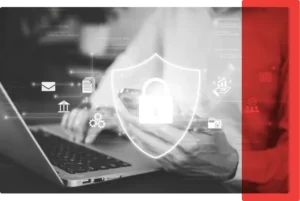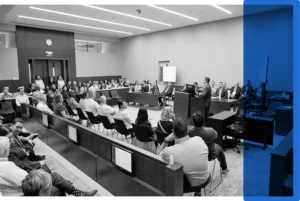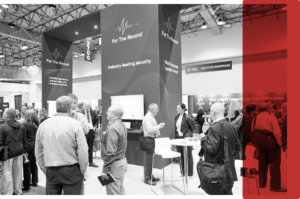
08 Sep
2022
The World of Capturing the Court Record: Interview with a Digital Court Reporter—Part One
his is part one of three in a series of interviews with Digital Court Reporter, Margaret Morgan. Read part two here.
The record turnout of digital court reporters and transcribers (gathering in-person for the first time since 2019) at the American Association of Electronic Reporters and Transcribers (AAERT) Annual Conference in Milwaukee in June showed the association continues to grow and progress—as does digital court reporting and transcription in general.
One person in attendance was Margaret Morgan, a District Court Reporter based in Minnesota. Margaret has been a digital court reporter for 28 years and has seen massive change in technology and court reporting during that time.
Margaret generously agreed to sit down with us to discuss the differences between roles in the court reporting industry, her journey to working as a District Court Reporter in Minnesota, and her everyday experiences within the industry.
This is the first installment in a three-part series in which Margaret shares her knowledge and insights with us.
Would you explain the differences between a digital court reporter, stenographer, and an audio transcriber?
A digital or electronic court reporter captures the record using a computer and sophisticated multi-channel digital recording platform. The digital court reporter monitors the proceeding as it is recorded and simultaneously creates detailed annotations that are date- and time-stamped and linked to the digital recording.
Confidence monitoring the proceeding [listening to the proceeding through a headset as it is recorded] ensures the capture of an accurate and complete record. Additionally, in Minnesota, digital court reporters prepare transcripts of the proceedings they report when requested.
A stenographic court reporter or stenographer captures the record using a stenographic machine or “writer,” typing shorthand briefs that software translates to text. With this technology, stenographic reporters instantly have a draft transcript. Most stenographic reporting systems also contain a single-channel backup digital recording.
An audio transcriber listens to the digital recording to transcribe the words—they reduce the spoken word to text. The transcriber refers to the digital court reporter’s annotations for proper spelling of unique words and phrases, and party identification. An audio transcriber may transcribe using a QWERTY keyboard using shortcut or text expanders, voice recognition, or stenography.
How long did you train/study to become a digital court reporter? What sort of continuing education do you need to complete for your role?
While I had some college, I was primarily hired based on my ten years of legal experience, which was gained working in civil and criminal law firms. I am familiar with the court system in both civil litigation and criminal proceedings.
My experience included managing files and exhibits, transcribing dictation, preparing cases for trial, and summarizing depositions. My legal experience is invaluable—it allows me to do more than capture the record and prepare transcripts, which is helpful to Judge Chase.
When I started reporting in 1994, there were few electronic court reporters in the area, but I shadowed the electronic reporter I replaced. At that time, we captured the record via cassette tapes and handwriting annotations.
Having heard about the lack-of-education criticism directed at electronic court reporters at that time, I looked at the curriculum of the stenography program and returned to college to supplement my prior education with additional English and writing courses, critical thinking, business law, sociology, psychology courses, and more.
I was always strong in English, I was comfortable with technology, and I had a broad legal background. My combined education and work experience is equal to, or greater than, the academics of a traditional court reporting program. With that education and experience, learning the reporting aspects of the job, including the digital reporting software and how to write good notes, did not take long.
The Minnesota Judicial Branch requires digital court reporters to be certified through State Court Administration or AAERT. Once hired, I passed the written knowledge and transcript tests for state certification. Within a couple of years, I passed the AAERT certification tests for court reporters and transcribers.
To maintain my certifications, I rely on AAERT and the Minnesota Judicial Branch for continuing education—AAERT offers a variety of educational sessions all directly related to digital reporting and transcription, while the judicial branch also offers a wide variety of topics.
Additionally, court reporters and transcriptionists can never get enough of grammar and punctuation tips to reduce the spoken word to text, so AAERT continues to hold those type of educational sessions.
Technology is especially important in this industry. Technological advancements will change how we work, and it is essential we keep up-to-date and embrace the changes to ensure we are as efficient and accurate as possible.
For anyone interested in a career in digital court reporting or transcription, I suggest they seek out an AAERT-approved school. There are some excellent programs now.
Joining a Facebook group for digital court reporters and transcribers will give a new digital court reporter or transcriber access to experienced industry professionals—and of course, AAERT.
For people who don’t know anything about the process, would you explain what you do on a day-to-day basis?
I work for the Minnesota Judicial Branch and for Judge Joseph Chase. My primary responsibilities are to capture an accurate and complete record, write detailed annotations, prepare transcripts, and handle administrative tasks and technology for Judge Chase.
When not in court, I assist in drafting orders and correspondence, prepare jury instructions and verdict forms, transcribe the judge’s dictation, review the format of decisional memorandums, and finalize them for the judge’s signature.
Every morning I perform a comprehensive system check to ensure the technology is functioning properly and as expected.
While in court, I confidence monitor and write detailed annotations. If something occurs that impacts the record, I interrupt the proceeding to correct the situation—this includes people talking simultaneously, an attorney straying too far from a microphone, or asking for a verbal response.
At the end of the day, I back up the audio and annotations to an external hard drive—I do that twice. I also work closely with IT on courtroom technology installations and updates as it all impacts the court record.
If an order is required following a hearing, I generally prepare the first draft. The judge may make edits, and then I will finalize formatting for his signature. Once the judge signs it, the document goes to court administration for processing. This entire process is completed electronically now, so we can be in different locations.
Court reporters also work for each other—regardless of reporting method. In the courthouse where I work, there are eight court reporters: six digital and two stenographic. When I started there were two digital and five stenographic reporters. We cover each other’s calendars when we are available.
When a transcript is requested, I prepare it outside of regular work hours—on weekends and periodically before or after work.
This is part one in a three-part series of interviews with Digital Court Reporter, Margaret Morgan. Read part two and part three.



